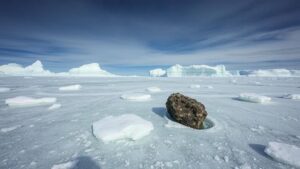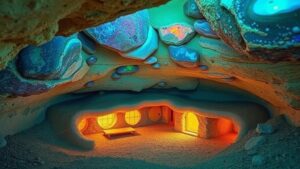Investigating basalt formations in the Mogollon-Datil Volcanic Province for hidden geodes and thundereggs.
Investigating Basalt Formations in the Mogollon-Datil Volcanic Province
The Mogollon-Datil Volcanic Province, located in western New Mexico, is a premier destination for rockhounds and mineral collectors. This geological wonder contains an array of fascinating basalt formations known for their unique attributes and the potential to uncover stunning hidden geodes and thundereggs. This article will explore the characteristics of these formations, the process of finding hidden treasures, and practical tips for rock collectors.
An Overview of Basalt Formations
Basalt is an igneous rock formed from the rapid cooling of lava exposed at or near the surface of a planet. With a fine-grained texture and dark color, basalt typically contains minerals like pyroxene, olivine, and plagioclase. In the Mogollon-Datil Volcanic Province, these formations date back as far as 35 million years, showcasing the enduring geological processes that have shaped this unique landscape.
Geodes and Thundereggs: A Hidden Treasure
Geodes are spherical rock formations that often contain beautiful crystals and mineral deposits inside. Thundereggs, on the other hand, are a type of nodule, generally derived from volcanic activity, that can contain agate, quartz, or even opal centers. Both formations provide fascinating insights into the regions volcanic activity and mineralogy.
Identifying Potential Locations
When searching for geodes and thundereggs, identifying the right locations is crucial. Look for areas with the following characteristics:
- Exposed Basalt Outcrops: Natural erosion or quarrying can reveal the cross-section of basalt formations.
- Concentrations of Volcanic Ash: This indicates past volcanic activity, which is essential for thunderegg formation.
- Water Erosion Sites: Riverbeds or areas near springs can expose hidden formations that have been eroded away.
The Geology of Geodes and Thunderegg Formation
Geodes typically form when mineral-rich water seeps into voids within the basalt. As the water evaporates, it leaves behind mineral deposits that crystallize over time. process can take thousands to millions of years, depending on environmental conditions.
Thundereggs form when volcanic ash layers trap bubbles and spaces in the cooling rock. Over time, mineral-rich solutions seep into these voids, filling them and sometimes forming beautiful agate or quartz centers. Understanding the formation processes can greatly enhance the collectors ability to spot potential finds.
Tools and Techniques for Collecting
Having the right tools and techniques will improve your chances of finding quality geodes and thundereggs. Consider the following:
- Hammers and chisels: Essential for breaking open rocks to reveal hidden treasures.
- Safety goggles: Protect your eyes during the rock-breaking process.
- Shovels or trowels: Useful for excavating larger areas or digging around potential finds.
- Field guides: Reference materials that help identify different rocks and minerals.
- Backpack: To carry your valuable finds and tools.
Real-World Applications for Collectors
For those interested in geology, rockhounding can serve as a practical application of scientific principles learned in the classroom. It offers hands-on experience with mineral identification, geological processes, and the intricacies of earth sciences. Also, for collectors, both geodes and thundereggs can be valuable for display or even resale purposes, particularly high-quality, well-formed specimens that can fetch premium prices in the collectors market.
Exploring Responsibly
As you embark on your rockhounding adventure, it is crucial to follow local laws and guidelines regarding collection. Many areas within the Mogollon-Datil Volcanic Province may have regulations in place to protect the natural environment. It is advisable to:
- Seek permission before exploring private lands.
- Avoid overly disturbed areas where ecosystems may be harmed.
- Leave no trace: Take only pictures and leave the area as you found it.
Conclusion
The Mogollon-Datil Volcanic Province stands as an exceptional landscape for rockhounds and mineral collectors seeking to discover remarkable geodes and thundereggs. By understanding the geology, utilizing proper tools, and exploring responsibly, collectors can uncover treasures hidden within the basalt formations while fostering a deeper appreciation for the Earths geological history.
Whether for personal collection or for educational purposes, the pursuit of geodes and thundereggs in this volcanic paradise can lead to profound discoveries and a greater understanding of the intricate processes that shape our planet.



